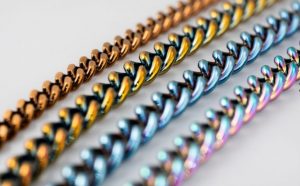 MENDRISIO, Switzerland — October 28, 2024 — Oerlikon Riri and Oerlikon Fineparts, the luxury brands of Oerlikon, are further expanding the use of their advanced Physical Vapour Deposition (PVD) processes, leveraging Oerlikon Balzers’ technological expertise. Oerlikon aims to raise its profile as the leading provider of high-quality, environmentally-friendly finishes for the luxury sector, balancing style, performance, and sustainable improvement.
MENDRISIO, Switzerland — October 28, 2024 — Oerlikon Riri and Oerlikon Fineparts, the luxury brands of Oerlikon, are further expanding the use of their advanced Physical Vapour Deposition (PVD) processes, leveraging Oerlikon Balzers’ technological expertise. Oerlikon aims to raise its profile as the leading provider of high-quality, environmentally-friendly finishes for the luxury sector, balancing style, performance, and sustainable improvement.
 Oerlikon recently installed a new Oerlikon PVD equipment at the Fundão plant in Portugal, a center of excellence for surface treatments. It is designed, manufactured and engineered by Oerlikon Balzers, allowing Oerlikon Riri and Oerlikon Fineparts to produce high volumes of PVD finished components with impeccable quality and homogenous surface finish.
Oerlikon recently installed a new Oerlikon PVD equipment at the Fundão plant in Portugal, a center of excellence for surface treatments. It is designed, manufactured and engineered by Oerlikon Balzers, allowing Oerlikon Riri and Oerlikon Fineparts to produce high volumes of PVD finished components with impeccable quality and homogenous surface finish.
“The increased adoption of PVD technology perfectly aligns with our goal of creating high-performance, sustainable products for the luxury market,” says Katharina Rick, President of the Luxury business sector at Oerlikon. “In a challenging time for the luxury market, our efforts are focused on minimizing our environmental footprint while providing our clients with finishes that meet the highest standards of beauty and durability. PVD allows us to redefine the perception of metallic finishes in fashion, bringing a new level of sophistication and sustainability to our offerings.”
Creating sustainable products for the luxury industry using PVD
 Physical Vapour Deposition is a thin-film coating process that distinguishes itself from traditional galvanic techniques, offering numerous benefits. From a technical perspective, it provides greater resistance to scratches and oxidation, extending the lifecycle of luxury accessories and ensuring they retain their visual appeal over time. A key advantage of this process is its ability to create durable and uniform finishes on accessories, providing customers a range of colors and effects that are challenging to achieve through conventional technologies.
Physical Vapour Deposition is a thin-film coating process that distinguishes itself from traditional galvanic techniques, offering numerous benefits. From a technical perspective, it provides greater resistance to scratches and oxidation, extending the lifecycle of luxury accessories and ensuring they retain their visual appeal over time. A key advantage of this process is its ability to create durable and uniform finishes on accessories, providing customers a range of colors and effects that are challenging to achieve through conventional technologies.
From an environmental standpoint, the benefits of PVD are even more evident. After conducting an internal analysis to compare the differences between a PVD-treated stainless steel accessory and electroplating-treated brass version, PVD resulted in a 76% reduction in overall environmental impact measured in kg CO2 equivalent. The process eliminates water usage entirely, achieving a 100% saving in water consumption. This also results in a 97% decrease in waste and a substantial saving in the use of precious metals, contributing to an 83% reduction in CO2 emissions related to raw material sourcing and processing.
Moreover, PVD’s use of stainless steel as a base material, instead of the more commonly used brass, further enhances the sustainability profile of the item. Stainless steel components are 6% lighter than brass equivalents, resulting in both lower transportation emissions and improved comfort when wearing luxury accessories. They are produced by MIM (Metal Injection Moulding) which significantly reduces scraps in the production process. Indeed, the raw material utilization for MIM exceeds 95%, whereas cold forging combined with machining processes achieves approximately 60%. The shift to stainless steel also eliminates the risk of lead contamination and improves the longevity of products by avoiding oxidation. This allows accessories to maintain their original aesthetic over a long period of time.
Posted: October 28, 2024
Source: Oerlikon




